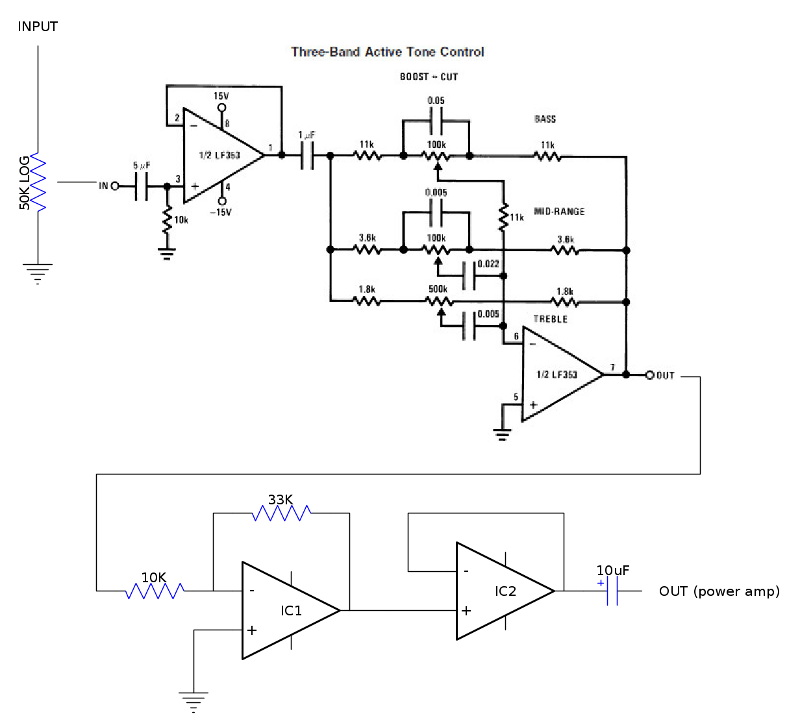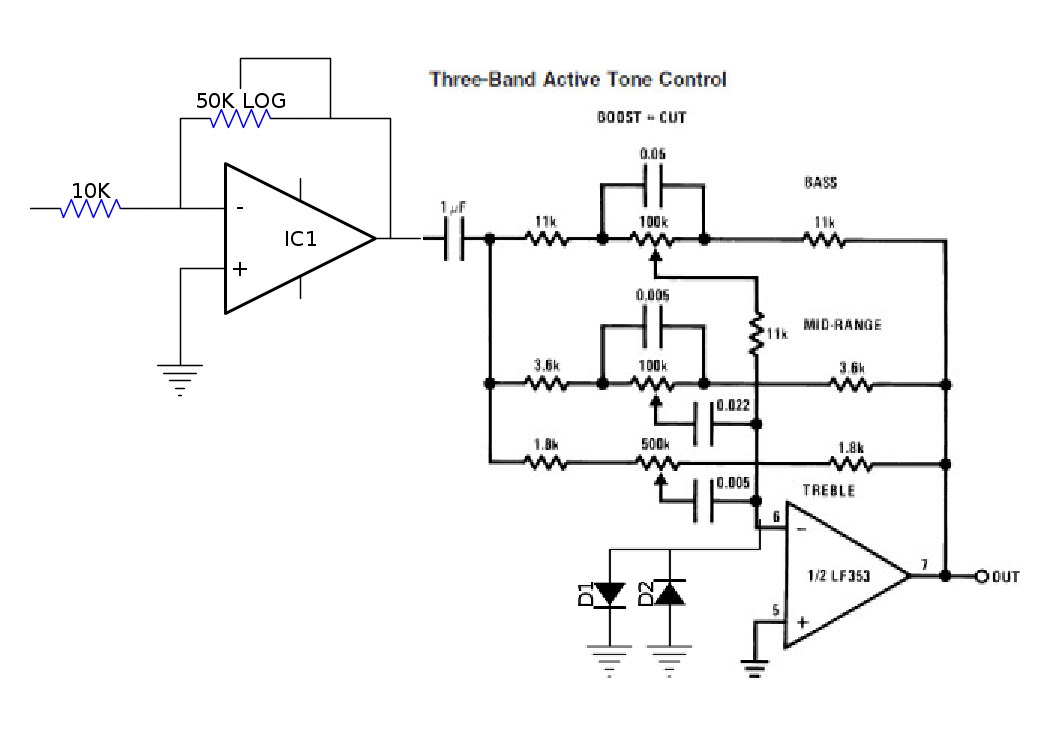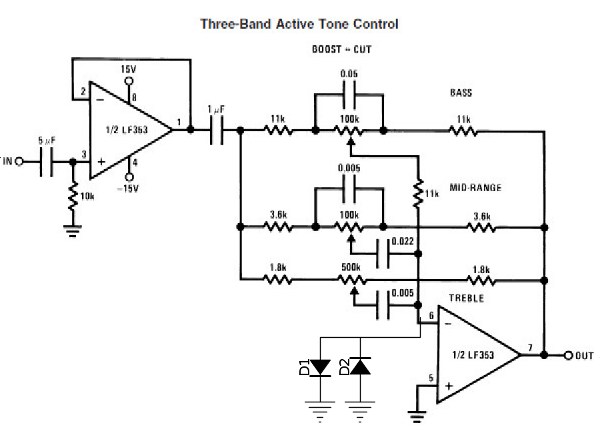Hi!
I'm building a bass preamp (not my first). I'm using a three band active baxandall tonestack found in the LF353 datasheet (I'm using OPA2134 however).
If I'm not completely lost, this tonestack produces an inverted signal, and would need to be re-inverted. Right? So I plan to put an inverting gain stage after it, and then use the remaining opamp section as an output buffer. Does this seem at all sensible to you?

I'm building a bass preamp (not my first). I'm using a three band active baxandall tonestack found in the LF353 datasheet (I'm using OPA2134 however).
If I'm not completely lost, this tonestack produces an inverted signal, and would need to be re-inverted. Right? So I plan to put an inverting gain stage after it, and then use the remaining opamp section as an output buffer. Does this seem at all sensible to you?

I don't know, maybe it isn't necessary? What if I want to split the signal with a DI box before the preamp, wouldn't I have both an inverted an non-iverted signal on stage?Why bother?
The signal will be inverted, no doubt, but it usually does not matter.
Even if you use a direct box, it will go to the PA, away from the stage.
In fact many amps invert at random, sometimes even in the same amp (as in Fender Twins) where if you jumper both channels, you lose signal big way, because they go to the same power amp and speaker (not your case).
And if you join many amps on stage, you'll typically chain drive them from your main preamp out to all other power amps, which *usually* (95% of them), are non inverting.
But anyway we are talking about a single op amp stage, so go ahead if you wish, and add a "phase" switch, to select taking signal before or after it.
Most PA and recording mixers have that available.
It might be useful in some situation if, say, you drive 2 amps, straight at their inputs, from, say, some Bass effects processor.
Even if you use a direct box, it will go to the PA, away from the stage.
In fact many amps invert at random, sometimes even in the same amp (as in Fender Twins) where if you jumper both channels, you lose signal big way, because they go to the same power amp and speaker (not your case).
And if you join many amps on stage, you'll typically chain drive them from your main preamp out to all other power amps, which *usually* (95% of them), are non inverting.
But anyway we are talking about a single op amp stage, so go ahead if you wish, and add a "phase" switch, to select taking signal before or after it.
Most PA and recording mixers have that available.
It might be useful in some situation if, say, you drive 2 amps, straight at their inputs, from, say, some Bass effects processor.
Thanks for your replies! So basically it doesn't make any difference if I make the gain stage inverting or non-inverting? But if I have a separate gain stage, there's no harm in making the first section inverting like in my mockup, right?
You have to be carefull in musical instrument amps when using non-inverting stages like the first stage in your schematic. If the input goes below about -12V, the output of that stage will slam the positive rail because the input common mode range has been exceeded. It's better to use an inverting stage there (noise may be higher), even better to add anti-parallel diodes at the summing junction to ground. This is why many opamp circuits have a reputation of sounding bad.
Yes, that would work but I would suggest that you make the input buffer inverting. Many modern bass amps use a variable gain stage as an input buffer between the bass guitar and any tone shaping circuits.
Ok, thanks I'll try that!Yes, that would work but I would suggest that you make the input buffer inverting. Many modern bass amps use a variable gain stage as an input buffer between the bass guitar and any tone shaping circuits.
Did I understand you correctly, something like this? (I'm thinking the gain pot should be reverse log in this case.)
This would be a neat solution (if it's plausible), I'm a bit worried about input impedance though.

BTW: feel free to stop answering when you grow tired of my questions 🙂
This would be a neat solution (if it's plausible), I'm a bit worried about input impedance though.

BTW: feel free to stop answering when you grow tired of my questions 🙂
Hi, if you use an LF353 I don't see a problem. It has a Jug Fet input, so very high impedance, most preamps are 50K and this one is several Meg Ohms.
Take your 10K to ground and 470K from pin 3 to ground and then feed your signal in through a 100n Cap and a 10K resistor in series.
I think you will find that will do more than you hoped for.
Regards.

Take your 10K to ground and 470K from pin 3 to ground and then feed your signal in through a 100n Cap and a 10K resistor in series.
I think you will find that will do more than you hoped for.
Regards.

Search for a bass pream specific schematic.
The one in the datasheet is fine ... for a Hi Fi preamp, with +/-15V rails, driven from a low impedance, etc.
You need high input impedance to properly load your pickups (the 470K suggested above instead of 10 K is fine) and running out of a 9V battery is more practical in that situation.
The one in the datasheet is fine ... for a Hi Fi preamp, with +/-15V rails, driven from a low impedance, etc.
You need high input impedance to properly load your pickups (the 470K suggested above instead of 10 K is fine) and running out of a 9V battery is more practical in that situation.
Here is a link to a nice bass preamp built around the 3 band Baxandall EQ. It uses JFETs but it will get you started. Link: http://www.albertkreuzer.com/pics/el/pre/schem/preamp_sch21.gif
- Status
- Not open for further replies.
- Home
- Live Sound
- Instruments and Amps
- Bass preamp: non-inverting an inverting tone stack (opamp)
